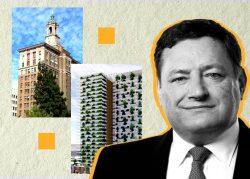Westbank and Urban Community are poised to break ground on a leafy, 540-unit apartment tower in Downtown San Jose.
The Vancouver- and San Jose-based developers aim to put shovels in dirt by spring for their Orchard Residential highrise at 409 South Second Street, in SoFa, the San Francisco Mercury News reported.
It would replace a Bo Town restaurant, which closed five years ago, while preserving its well-known structure.
“Bo Town, which is at Second and San Salvador, we’ll be breaking ground on that in the next few months,” Gary Dillabough, co-founder of Urban Community, told the San Jose Rotary Club last week.
The project is among three environmentally friendly tower proposals by Westbank and Urban Community in Downtown. In 2022, Chicago-based Cushman & Wakefield had sought $1.5 billion in financing, through syndication involving pools of funds for the three projects.
All three “net-zero” projects would include trees, vines and other plants popping from stairways, terraces and rooftops inside what Westbank calls its “net-zero” Downtown campus — which aims to be carbon neutral and environmentally sustainable.
Plans for Orchard Residential, approved in late 2022, include a 30-story apartment tower with 540 units and 7,500 square feet of ground-floor shops and restaurants. Its jutting balconies appear overgrown with trees and plants beneath a Googie-style zig-zag roof, according to a rendering.
Park Habitat, a 20-story office and retail tower at 180 Park Avenue, broke ground in April 2022 and is expected to be completed next year.
The 1.2 million-square-foot office and retail complex will expand the Tech Interactive museum. It will also include numerous gardens, as well as a “green lung” ventilation system to allow people to essentially work in a park.
Last week, Westbank and Urban Community updated plans for the third project to convert the century-old, 13-story Bank of Italy building into as many as 150 homes at 12 South First Street.
The Mediterranean Revival and Beaux-Arts landmark, designed by Henry Minton, was built in 1926 for the Bank of Italy, the forerunner of Bank of America. It’s listed on the National Registry of Historic Places.
— Dana Bartholomew
Read more



